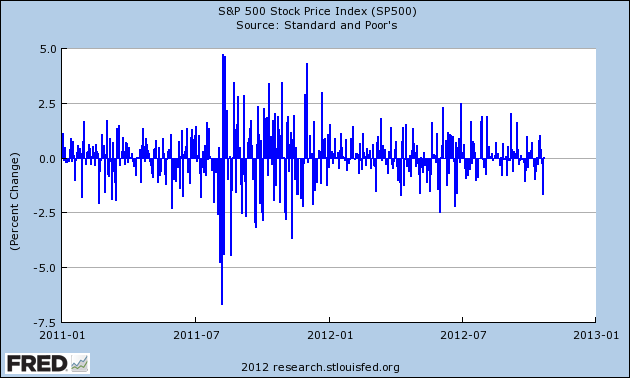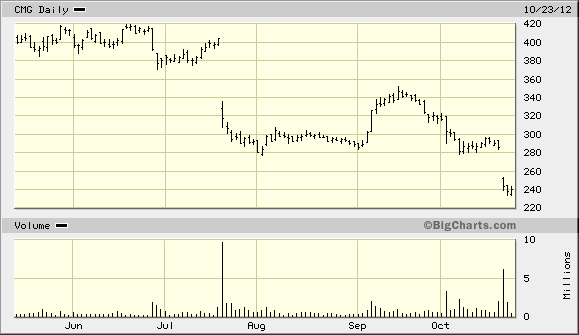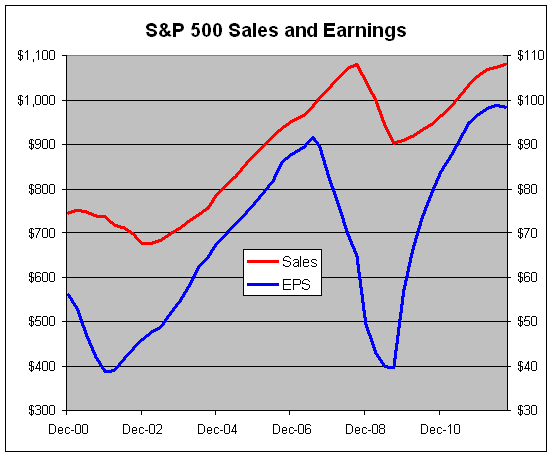Archive for October, 2012
-
Morning News: October 24, 2012
Eddy Elfenbein, October 24th, 2012 at 5:50 amGerman Ifo Business Confidence Unexpectedly Fell in October
Despite Push for Austerity, European Debt Has Soared
China Industry Gauge Rises as Easing Prospects Abate
Brazil Soybean Crop Estimated 47% Sold by Soybean & Corn Advisor
Dow Falls 234 Points As Corporate Earnings Disappoint Investors
The Fraught Fed-Chairman Choice
Facebook Posts A Loss But Makes Gains On Mobile Ad Revenue
Ford to Shut Belgian Plant in Shift to Spain, Union Says
Peugeot Gets French State Backing as Debt Load Increases
LG Electronics Posts 3rd-Quarter Profit on Phone Earnings
Netflix Tumbles After Subscriber Growth Trails Estimates
CFPB Issues Rules For Governing Debt Collectors
Cullen Roche: Who Should Replace Ben Bernanke and Timothy Geithner?
Joshua Brown: Where Did All The Finance Bloggers Go? My Theories.
Be sure to follow me on Twitter.
-
AFLAC Beats, Guides Higher and Raises Its Dividend for the 30th Year in a Row
Eddy Elfenbein, October 23rd, 2012 at 5:21 pmAFLAC’s ($AFL) earnings are out and they were very good. The company is raising full-year guidance and implying an increase to next year as well. If that isn’t enough, AFLAC raised its dividend for the 30th year in a row.
Now let’s look at some numbers.
Revenues rose 14.4% to $6.8 billion. Operating earnings, which is what we want to watch for with insurance companies, rose to $831 million which is $1.77 per share. Wall Street had been expecting $1.66 per share, so this was an impressive beat. Interestingly, the yen/dollar rate had no impact on operating earnings. Three months ago, AFLAC told us to expect earnings to be between $1.64 and $1.69 per share, so Q3 was much better than expectations.
The quarter was helped by two items:
In the quarter, the company revised its estimate of the full-year effective tax rate, which increased operating earnings by $17.5 million, or $.04 per diluted share. In addition, the company recognized an income tax benefit of $29.5 million, or $.06 per diluted share, primarily resulting from the favorable outcome of a routine tax exam for the years 2008 and 2009. Together, the impact from these items benefited operating earnings by $47 million, or $.10 per diluted share.
For the first three quarters of this year, revenues were up 17.3% to $19.0 billion, and operating earnings were $2.4 billion or $5.12 per share.
AFLAC is also raising its quarterly dividend by two cents per share or 6.1%. The dividend will rise from 33 cents to 35 cents per share. This is the 30th year in a row the company has increased its dividend. Going by today’s close, AFL yields 2.82%.
AFLAC expects Q4 operating earnings (assuming no impact from currency) to range between $1.46 and $1.51 per share. That means the full-year number will range between $6.58 and $6.63 per share. The previous full-year guidance was for $6.45 to $6.52 per share.
The company also revised higher its full-year sales forecast for AFLAC Japan to a growth rate of 30% to 35%.
AFLAC expects operating earnings for 2013 to rise by 4% to 7% (on a currency neutral basis). Working off the higher base for 2012, that implies $6.84 to $7.09 for next year. Wall Street currently expects 2013 EPS of $6.88.
-
CR Bard Earns $1.64 Per Share
Eddy Elfenbein, October 23rd, 2012 at 4:12 pmOne of the few stocks that was up today, CR Bard ($BCR) just reported Q3 earnings of $1.64 per share. That beat the Street’s forecast by one penny per share. Three months ago, Bard told us to expect earnings to range between $1.60 and $1.64 per share.
C. R. Bard, Inc. today reported 2012 third quarter financial results. Third quarter 2012 net sales were $722.9 million, an increase of 1 percent over the prior-year period on a reported basis. Excluding the impact of foreign exchange, third quarter 2012 net sales increased 3 percent over the prior-year period.
For the third quarter 2012, net sales in the U.S. were $483.4 million, a decrease of 1 percent from the prior-year period. Net sales outside the U.S. were $239.5 million, an increase of 3 percent over the prior-year period on a reported basis. Excluding the impact of foreign exchange, third quarter 2012 net sales outside the U.S. increased 11 percent over the prior-year period.
For the third quarter 2012, net income was $129.3 million and diluted earnings per share available to common shareholders were $1.50, a decrease of 1 percent and an increase of 3 percent, respectively, as compared to third quarter 2011 results. Adjusting for items that affect comparability between periods as detailed in the tables below, third quarter 2012 net income was $141.4 million and diluted earnings per share available to common shareholders were $1.64, a decrease of 2 percent and an increase of 1 percent, respectively, as compared to third quarter 2011 results.
Timothy M. Ring, chairman and chief executive officer, commented, “We delivered adjusted earnings per share at the top end of our guidance range this quarter, despite significant headwinds in the United States. Our international investments are shifting the mix of our portfolio to faster growing markets, which remains a key focus for us as we continue to improve our growth profile by investing in geographic and product markets with superior growth opportunities.”
-
“Stocks Are Hammered.” Really?
Eddy Elfenbein, October 23rd, 2012 at 3:42 pmI noticed this story from the AP which announces that “Stocks are hammered by weak earnings reports.”
Hammered?
The S&P 500 is currently down 1.31%. That’s the second-worst day in nearly four months. Last Friday was worse.
But how soon we forget. Today is on track to be the 10th worst day of the year. But today’s loss would only rank as the 36th worst of 2011.
That’s how much daily volatility has dried up since last year.
-
Life Imitates The Onion
Eddy Elfenbein, October 23rd, 2012 at 12:53 pmFive years ago, The Onion reported:
Even CEO Can’t Figure Out How RadioShack Still In Business
Despite having been on the job for nine months, RadioShack CEO Julian Day said Monday that he still has “no idea” how the home electronics store manages to stay open.
“There must be some sort of business model that enables this company to make money, but I’ll be damned if I know what it is,” Day said. “You wouldn’t think that people still buy enough strobe lights and extension cords to support an entire nationwide chain, but I guess they must, or I wouldn’t have this desk to sit behind all day.”
The retail outlet boasts more than 6,000 locations in the United States, and is known best for its wall-sized displays of obscure-looking analog electronics components and its notoriously desperate, high-pressure sales staff. Nevertheless, it ranks as a Fortune 500 company, with gross revenues of over $4.5 billion and fiscal quarter earnings averaging tens of millions of dollars.
“Have you even been inside of a RadioShack recently?” Day asked. “Just walking into the place makes you feel vaguely depressed and alienated. Maybe our customers are at the mall anyway and don’t feel like driving to Best Buy? I suppose that’s possible, but still, it’s just…weird.”
Reality is finally catching up to Radio Shack ($RSH). In December 1999, the stock was close to $80. This morning, it gapped down to $2. The company just reported another terrible quarter:
RadioShack reported a larger-than-expected loss for its third quarter as the electronics retailer’s revenue slipped.
The struggling company has seen its profits erode over the past two years and in September it announced the departure of CEO James Gooch. The chain’s troubles are partly due to wider problems in the brick-and-mortar electronics industry and add fuel to the notion that selling consumer electronics in brick-and-mortar stores is becoming less and less viable.
Interim CEO Dorvin Lively said that RadioShack had raised $175 million in new financing during the quarter and used those proceeds and some available cash to repay some debt.
After falling in premarket trading, RadioShack shares rose 10 cents, or 4.2 percent, to $2.49 in midday trading.
For the three months ended Sept. 30, RadioShack Corp. lost $47.1 million, or 47 cents per share. That compares with a net income of $300,000, or breakeven results, a year earlier.
I don’t see how the company can survive.
-
Chipotle Continues to Fall
Eddy Elfenbein, October 23rd, 2012 at 10:56 amIn May, I listed 13 stocks to avoid. Since then, most of the stocks have dropped. The biggest loser is Chipotle ($CMG) which is off over 41% since I first listed it.
The sell-off has brought the stock back closer to reality. In my opinion, a fair value for CMG is $195.
-
S&P 500 Down Again, Bernanke Out in 2014
Eddy Elfenbein, October 23rd, 2012 at 10:04 amAs I suspected, once the S&P 500 pierced its 50-DMA, the bears got much more confident. For the second time in the last three days, the stock market is getting hit hard. The S&P 500 is down to 1,414 which is its lowest level since September 6th.
Andrew Ross Sorkin reports in the New York Times this morning that Ben Bernanke may leave the Fed when his term expires in 14 months, no matter who wins the election.
But there is another wrinkle in the parlor game calculus: Ben Bernanke, the Federal Reserve chairman, is likely to need a successor, too. If Mitt Romney wins the presidency, he has already pledged he will replace Mr. Bernanke, whose term as chairman ends in January 2014, in just over 15 months. However, Mr. Bernanke has told close friends that even if Mr. Obama wins, he probably will not stand for re-election.
The good news for us is that our Buy List continues to do well. Reynolds American ($RAI) reported Q3 earnings this morning of 79 cents per share which matched Wall Street’s estimate. Revenues fell 3.8% to $2.12 billion which was $60 million below consensus.
To me, the most important news is that Reynolds reaffirmed its full-year forecast of $2.91 to $3.01 per share. For the first three quarters, Reynolds earned $2.21 per share so that means they see Q4 coming in between 70 and 80 cents per share. I don’t think they’ll have any trouble hitting that.
Later today, we’ll get earnings from AFLAC ($AFL) and CR Bard ($BCR).
-
Morning News: October 23, 2012
Eddy Elfenbein, October 23rd, 2012 at 6:55 amBillionaire Ross Interested in Buying Spanish Bank Assets
A Tight Rope on China’s Currency
Iran Says May Stop Oil Sales If Sanctions Tighten
Pfizer in Deal to Acquire NextWave
Yahoo Rises as CEO Sees Growth in Technology, Small Deals
Walmart, Temp Agencies Sued For Minimum Wage, Overtime Violations
BP Will Switch Russian Partners Through a Deal With Rosneft
Netflix Needs Growth Surge for Goal of 7 Million New U.S. Users
Texas Instruments Forecasts Earnings MIssing Estimates
Nokia To Issue €750m Bond To Boost Cash
Permira Agrees to Buy Ancestry.com for About $1.6 Billion
What Hasbro Earnings Mean to Investors
I Like Coal: Peabody Ultra-Bullish On Coal As Natural Gas Prices Double
Roger Nusbaum: Buy and Hold is Not Entirely Dead
Howard Lindzon: Goldman Sachs…Whistleblowers… and Muppets
Be sure to follow me on Twitter.
-
The Future of Computers
Eddy Elfenbein, October 23rd, 2012 at 12:32 amFrom 1976:
-
The Pressure on Margins
Eddy Elfenbein, October 22nd, 2012 at 2:22 pmHere’s a look at a chart that shows one of the most important dynamics of this market. Namely, corporate profit margins have been stretched about as far as they can go.
The blue represents the trailing four-quarter earnings of the S&P 500 and it follows the right scale. The red line is the trailing four-quarter sales and it follows the left scale. The two lines are scaled at a ratio of 10-to-1. That means that if the lines cross, profit margins are exactly 10%.
You’ll notice that the blue line closes the gap later in the cycle which means that profit margins rose. In this cycle, profits have risen considerably but sales haven’t grown very much. You can’t cut costs indefinitely. At some point, companies need to see greater sales growth in order to boost earnings. We’re currently right at the spot which has historically been the upper limit of profit margins. That doesn’t mean we can’t go higher, but it would be unprecedented.
-
-
Archives
- May 2025
- April 2025
- March 2025
- February 2025
- January 2025
- December 2024
- November 2024
- October 2024
- September 2024
- August 2024
- July 2024
- June 2024
- May 2024
- April 2024
- March 2024
- February 2024
- January 2024
- December 2023
- November 2023
- October 2023
- September 2023
- August 2023
- July 2023
- June 2023
- May 2023
- April 2023
- March 2023
- February 2023
- January 2023
- December 2022
- November 2022
- October 2022
- September 2022
- August 2022
- July 2022
- June 2022
- May 2022
- April 2022
- March 2022
- February 2022
- January 2022
- December 2021
- November 2021
- October 2021
- September 2021
- August 2021
- July 2021
- June 2021
- May 2021
- April 2021
- March 2021
- February 2021
- January 2021
- December 2020
- November 2020
- October 2020
- September 2020
- August 2020
- July 2020
- June 2020
- May 2020
- April 2020
- March 2020
- February 2020
- January 2020
- December 2019
- November 2019
- October 2019
- September 2019
- August 2019
- July 2019
- June 2019
- May 2019
- April 2019
- March 2019
- February 2019
- January 2019
- December 2018
- November 2018
- October 2018
- September 2018
- August 2018
- July 2018
- June 2018
- May 2018
- April 2018
- March 2018
- February 2018
- January 2018
- December 2017
- November 2017
- October 2017
- September 2017
- August 2017
- July 2017
- June 2017
- May 2017
- April 2017
- March 2017
- February 2017
- January 2017
- December 2016
- November 2016
- October 2016
- September 2016
- August 2016
- July 2016
- June 2016
- May 2016
- April 2016
- March 2016
- February 2016
- January 2016
- December 2015
- November 2015
- October 2015
- September 2015
- August 2015
- July 2015
- June 2015
- May 2015
- April 2015
- March 2015
- February 2015
- January 2015
- December 2014
- November 2014
- October 2014
- September 2014
- August 2014
- July 2014
- June 2014
- May 2014
- April 2014
- March 2014
- February 2014
- January 2014
- December 2013
- November 2013
- October 2013
- September 2013
- August 2013
- July 2013
- June 2013
- May 2013
- April 2013
- March 2013
- February 2013
- January 2013
- December 2012
- November 2012
- October 2012
- September 2012
- August 2012
- July 2012
- June 2012
- May 2012
- April 2012
- March 2012
- February 2012
- January 2012
- December 2011
- November 2011
- October 2011
- September 2011
- August 2011
- July 2011
- June 2011
- May 2011
- April 2011
- March 2011
- February 2011
- January 2011
- December 2010
- November 2010
- October 2010
- September 2010
- August 2010
- July 2010
- June 2010
- May 2010
- April 2010
- March 2010
- February 2010
- January 2010
- December 2009
- November 2009
- October 2009
- September 2009
- August 2009
- July 2009
- June 2009
- May 2009
- April 2009
- March 2009
- February 2009
- January 2009
- December 2008
- November 2008
- October 2008
- September 2008
- August 2008
- July 2008
- June 2008
- May 2008
- April 2008
- March 2008
- February 2008
- January 2008
- December 2007
- November 2007
- October 2007
- September 2007
- August 2007
- July 2007
- June 2007
- May 2007
- April 2007
- March 2007
- February 2007
- January 2007
- December 2006
- November 2006
- October 2006
- September 2006
- August 2006
- July 2006
- June 2006
- May 2006
- April 2006
- March 2006
- February 2006
- January 2006
- December 2005
- November 2005
- October 2005
- September 2005
- August 2005
- July 2005



 Eddy Elfenbein is a Washington, DC-based speaker, portfolio manager and editor of the blog Crossing Wall Street. His
Eddy Elfenbein is a Washington, DC-based speaker, portfolio manager and editor of the blog Crossing Wall Street. His